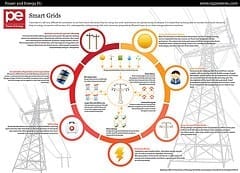In the wake of extreme weather, research is revealing that smart grids and micro-grids can help the electric grid cope
In the days leading up to Hurricane Sandy’s destructive march on the East Coast, utilities warned customers to prepare for widespread outages and potentially extensive power failure. The question was not if the grid would fail, but to what extent.
The storm highlighted an already well-known problem: The U.S. power grid is vulnerable to extreme weather. As officials from New York to Venice, Italy, have acknowledged in recent weeks, climate change is likely to increase the prevalence of such weather. And according to analysts and outside groups working on the problem, there is no one-size-fits-all remedy that can insulate the ailing grid against an escalation of the elements.
The conversation over extreme weather and U.S. transmission infrastructure is evolving, due in no small part to extreme weather events like Sandy, last summer’s “super derecho” and last year’s Hurricane Irene. These events have tested the grid and revealed its weaknesses, but they have also yielded valuable lessons — lessons that, if successfully implemented, could result in a better-equipped system able to weather the storms of the future.
Smart meters keep operators ahead of the storm
One such lesson has been the success of smart meters in anticipating and responding to large-scale weather events.
When scores of tornadoes spun across the Southeast in 2011, ripping through towns and leaving hundreds of thousands of Georgia Power and Southern Co. customers without electricity, the utilities relied on a widely installed network of smart meters to chart the storm’s path, identify high-priority customers like hospitals and fire stations, and deploy response teams to the hardest-hit areas.
In addition to speeding the recovery, the meters saved the utilities time and money. As Ed Carlsen, manager of distribution power systems for Georgia Power, told The Atlanta Journal-Constitution in 2011, “We were able to determine that hundreds of meters were actually on, so that saved us from rolling trucks out there.”
Smart meters aid grid resiliency in three primary ways, according to Chris Eisenbrey, director of business information at the Edison Electric Institute (EEI).
First, they act as remote sensors, alerting utilities to outages immediately and eliminating the need for customers to call in to report problems. Second, by providing utilities with a virtual map of outages, they allow response teams to be more efficiently deployed to the areas where they are most needed.
And finally, they allow the grid to be predictive rather than simply reactive — when a problem begins to occur, operators can shut down or reduce power to troubled sections of the grid, isolating issues before they can spread.
The final point is particularly important given the structure of the U.S. power grid, which some would call antiquated. In a storm or hurricane, the majority of outages occur not because of localized events such as falling tree limbs but due to the cascading impacts of a single outage spreading across a large swath of infrastructure.
“The grid is a radial system. It’s like a tree: There are twigs, there are branches, there’s a trunk,” said John Cooper, a partner at the consulting firm NextWatt Solutions and co-author of the book “The Advanced Smart Grid.” “Break a branch, and all the twigs on the branch are gone. Break the trunk, and the whole thing shuts down.”
The trick, he said, is to arrest the problem before it can spread from branch to twig.
via Scientific American – Nathanael Massey and ClimateWire
The Latest Streaming News: More Resilient Electric Grid updated minute-by-minute
Bookmark this page and come back often
Latest NEWS
Latest VIDEO








